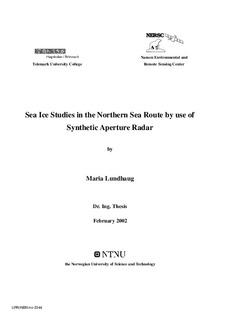| dc.description.abstract | The main objective of this thesis is to contribute to the understanding of sea ice processes in the Northern Sea Route, mainly with use of remote sensing data from Synthetic Aperture Radar (SAR). Multivariate data analysis is the main tool used in this work. SAR signatures of different sea ice types and open water in winter were studied, and separation of water and sea ice types using different multivariate regression algorithms was done. Polynya areas along the coasts were investigated. Structure characteristics of different sea ice types and open water were investigated. The summer sea ice in the Laptev Sea was also studied. The Laptev Sea as well as other parts of the Northern Sea Route are expected to become important areas for future oil and gas exploration and exploitation.
Results from a statistical analysis of 105 SAR images and corresponding meteorological data are presented, covering parts of the Pechora and Kara Sea in the Russian Arctic. Wind, temperature and other variables for the SAR sample areas were collected, and a manual sea ice classification of the SAR samples was performed. All variables were input to different multivariate regression techniques. First, ice was separated from water. Next, young ice was separated from rough first year ice. The study indicated that the mean and standard deviation of the backscattering coefficients together with temperature values were the most important information to separate the classes.
SAR image data has been used to investigate specific polynya events in detail, addressing widths, refreezing and duration. A polynya index derived from ice concentration data from Special Sensor Microwave Imager (SSM/I) was used in the description of polynya variability during a decade (1990-1999) in response to atmospheric forcing. The observed polynya widths were compared to the results from a simple one-dimensional polynya model. The best agreement was found for the Vize and Ushakova Island and the Novaya Zemlya coast due to low variability of polynya widths. Less agreement was found at the Yamal and Taymyr due to high polynya variability not captured by the model.
Sample areas of open water, young ice and first year ice were investigated by the angle measure technique (AMT) and classified by multivariate regression. The separation of ice and water was relatively sucessfull, opposed to the separation of young ice and first year ice. The individual samples were best separated on one pixel scale, corresponding to backscattering differences between neighboring pixels. The AMT produce mean angle information that to some extent can be related to ice type.
Finally, a demonstration and validation study of the capabilities of SAR imagery to provide accurate ice information to support ice navigation was carried out. The experiment was set up in August-September 1997. RADARSAT and ERS-2 SAR images combined with SSM/I data and in situ observations from icebreakers were used. These data were used to analyze ice concentration, ice types, ice drift and other ice features present in this period. The capability of RADARSAT ScanSAR and ERS SAR images to determine these ice parameters during late summer conditions in the Laptev Sea area is discussed. | nb_NO |
